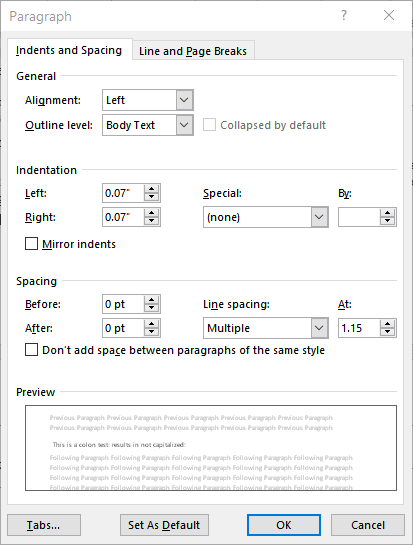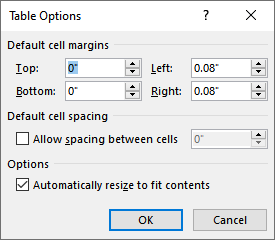Please Note: This article is written for users of the following Microsoft Word versions: 2007, 2010, 2013, 2016, 2019, Word in Microsoft 365, and 2021. If you are using an earlier version (Word 2003 or earlier), this tip may not work for you. For a version of this tip written specifically for earlier versions of Word, click here: Spacing Table Rows Vertically.
Written by Allen Wyatt (last updated September 24, 2022)
This tip applies to Word 2007, 2010, 2013, 2016, 2019, Word in Microsoft 365, and 2021
When you are working with tables, you may wonder how you can easily add space before a table row. This can be important when you have the table formatted with borders, and the text in the table is too close to the border at the top of the row. Word makes it easy to add space after the information in a row, simply by adjusting the height of the row itself so it is greater than the space occupied by the information in the row. But what about before a row?
An easy way to solve this problem is with paragraph formatting. If you have a single paragraph in each cell of a row, simply select the row. You can then follow these steps:

Figure 1. The Paragraph dialog box.
You can also use this method if you have multiple paragraphs in each cell. The difference, however, is that you should only select and format the top paragraph in each cell, instead of formatting the paragraphs in the row as a whole.
Another way to approach the problem is to adjust the margins used within the cells. The easiest way to do that is to follow these steps:

Figure 2. The Table tab of the Table Properties dialog box.

Figure 3. The Table Options dialog box.
WordTips is your source for cost-effective Microsoft Word training. (Microsoft Word is the most popular word processing software in the world.) This tip (5988) applies to Microsoft Word 2007, 2010, 2013, 2016, 2019, Word in Microsoft 365, and 2021. You can find a version of this tip for the older menu interface of Word here: Spacing Table Rows Vertically.

Create Custom Apps with VBA! Discover how to extend the capabilities of Office 2013 (Word, Excel, PowerPoint, Outlook, and Access) with VBA programming, using it for writing macros, automating Office applications, and creating custom applications. Check out Mastering VBA for Office 2013 today!
Need to adjust the width of a bunch of table columns according to what is in the columns? Word provides a tool to do ...
Discover MoreInsert a table in your document and Word assumes that you want borders around the table and its cells. Here's a shortcut ...
Discover MoreOne of the most common ways to format information in a table is to apply some sort of alignment to the contents of table ...
Discover MoreFREE SERVICE: Get tips like this every week in WordTips, a free productivity newsletter. Enter your address and click "Subscribe."
There are currently no comments for this tip. (Be the first to leave your comment—just use the simple form above!)
Got a version of Word that uses the ribbon interface (Word 2007 or later)? This site is for you! If you use an earlier version of Word, visit our WordTips site focusing on the menu interface.
Visit the WordTips channel on YouTube
FREE SERVICE: Get tips like this every week in WordTips, a free productivity newsletter. Enter your address and click "Subscribe."
Copyright © 2024 Sharon Parq Associates, Inc.
Comments